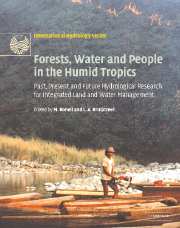 Forests, Water and People in the Humid Tropics
Forests, Water and People in the Humid Tropics Book contents
- Frontmatter
- Contents
- List of contributors
- Foreword
- Preface
- Acknowledgements
- Symposium and Workshop
- Introduction
- Part I Current trends and perspectives on people–land use–water issues
- Part II Hydrological processes in undisturbed forests
- 10 An overview of the meteorology and climatology of the humid tropics
- 11 Synoptic and mesoscale rain producing systems in the humid tropics
- 12 Climatic variability in the tropics
- 13 Controls on evaporation in lowland tropical rainforest
- 14 Runoff generation in tropical forests
- 15 Erosion and sediment yield in the humid tropics
- 16 Rainforest mineral nutrition: the ‘black box’ and a glimpse inside it
- 17 Hydrology of tropical wetland forests: recent research results from Sarawak peatswamps
- 18 Tropical montane cloud forest: a unique hydrological case
- Part III Forest disturbance, conversion and recovery
- Part IV New methods for evaluating effects of land-use change
- Part V Critical appraisals of best management practices
- Conclusion: Forests, water and people in the humid tropics: an emerging view
- Plate section
- References
11 - Synoptic and mesoscale rain producing systems in the humid tropics
from Part II - Hydrological processes in undisturbed forests
Published online by Cambridge University Press: 12 January 2010
- Frontmatter
- Contents
- List of contributors
- Foreword
- Preface
- Acknowledgements
- Symposium and Workshop
- Introduction
- Part I Current trends and perspectives on people–land use–water issues
- Part II Hydrological processes in undisturbed forests
- 10 An overview of the meteorology and climatology of the humid tropics
- 11 Synoptic and mesoscale rain producing systems in the humid tropics
- 12 Climatic variability in the tropics
- 13 Controls on evaporation in lowland tropical rainforest
- 14 Runoff generation in tropical forests
- 15 Erosion and sediment yield in the humid tropics
- 16 Rainforest mineral nutrition: the ‘black box’ and a glimpse inside it
- 17 Hydrology of tropical wetland forests: recent research results from Sarawak peatswamps
- 18 Tropical montane cloud forest: a unique hydrological case
- Part III Forest disturbance, conversion and recovery
- Part IV New methods for evaluating effects of land-use change
- Part V Critical appraisals of best management practices
- Conclusion: Forests, water and people in the humid tropics: an emerging view
- Plate section
- References
Summary
INTRODUCTION
A key facet of the hydrology and climatology of the humid tropics is the occurrence of more persistent high-rainfall intensities compared with those occurring over the higher latitudes. The equivalent hourly intensities of short-term rainfalls of, for example, over one minute, are commonly one or two orders of magnitude higher than those experienced in humid temperate areas (Bonell, 1993). Thus, the magnitude of rainfall is one of the principal drivers in accounting for the much wider range of preferred pathways of storm runoff in tropical forests (see Bonell, this volume). Less well appreciated in the literature is a possible linkage between preferred pathways of storm runoff and the spatial and temporal variability of different rain-producing meteorological systems. For example, there is a substantial difference in the range of rainfall intensity-frequency-duration characteristics identified with tropical cyclone-prone areas (e.g. northeast Queensland) as against tropical islands where trade wind ‘stream’ showers are more persistent (e.g. the Hawaiian Islands). Moreover, within the outer tropics, there can be a significant seasonal change in synoptic-scale meteorology systems and corresponding rainfall characteristics (notably rain intensities). In northeast Queensland, the dominant pathways of storm runoff in tropical forest show dramatic changes over a few months in response to a change from a monsoon regime of persistent tropical depressions (and cyclones) through to a regime dominated by upper troughs, and finally, stream showers associated with the SE trades (Bonell and Gilmour, 1980; Bonell et al., 1991).
- Type
- Chapter
- Information
- Forests, Water and People in the Humid TropicsPast, Present and Future Hydrological Research for Integrated Land and Water Management, pp. 194 - 266Publisher: Cambridge University PressPrint publication year: 2005
References
- 4
- Cited by


